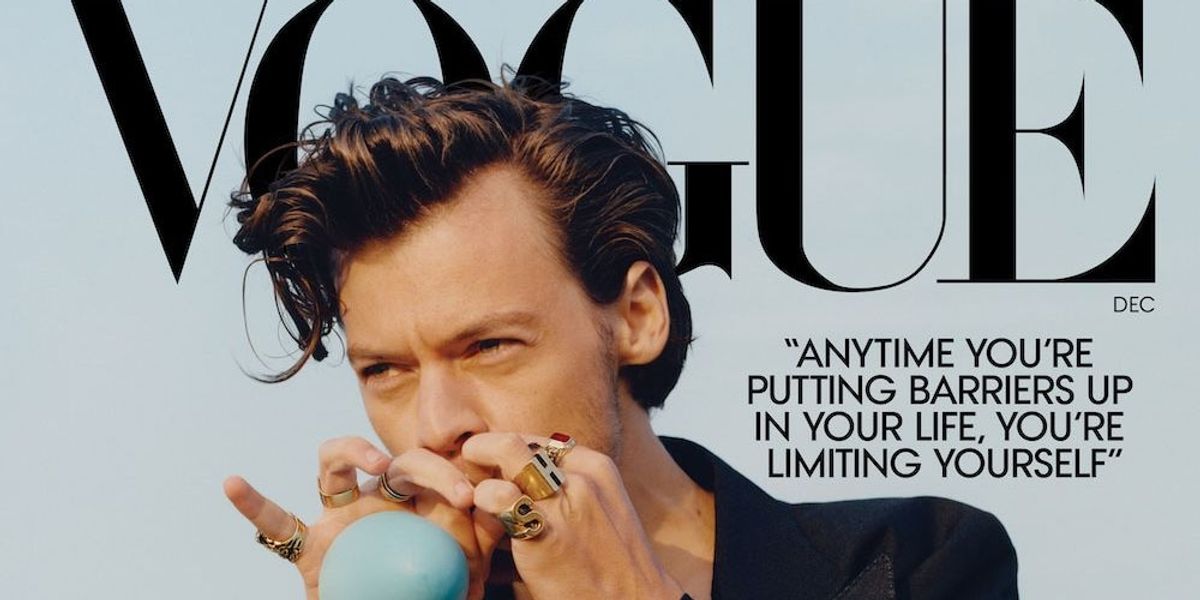
When Vogue magazine debuted their 2020 December issue, audiences were surprised to find a gowned Harry Styles on the cover.
The first man to appear solo on the cover of Vogue, Harry Styles is the picture of cool. Captured by Tyler Mitchell, whose career shot to prominence after being hand picked by Beyonce to shoot her September 2018 cover, Harry Styles wears an elaborate blue Gucci gown designed by his friend and frequent collaborator, Gucci’s Alessandro Michele.
This is not the first time Harry has tested the boundaries of gender norms in clothing. Since his departure from One Direction in August 2015, Harry’s solo career has been one defined by color and curiosity. No longer constrained by his 1D image, the “Watermelon Sugar” singer has taken the freedom to explore his own identity and tastes outside of any boundary he can break.
Naturally, this has opened him up to much media speculation, especially about his sexuality, all of which he has managed to expertly brush off with the ease of someone who is used to the scrutiny of fame.
No stranger to traditional women’s clothing, this is not the first time Harry has played with gender normativity in his wardrobe. But the added mantle of a Vogue cover has invited new levels of commentary and criticism.
Prominently, conservative commentator Candace Owens made a plea for America to “bring back manly men,” for which she has received severe backlash from celebrities such as Jameela Jamil and Olivia Wilde, as well as from fans and allies.
However, some of the commentary is more valid. Is it really so monumental that a cis white man has been allowed into a feminine space? Should Harry Styles be the face of gender non-conforming aesthetics, given his immense privilege?
In the interview for Vogue, Harry says: “There’s so much joy to be had in playing with clothes. I’ve never thought too much about what it means—it just becomes this extended part of creating something.”
While as an established, white artist, this may be true. However, for some, playing with gender norms is not so simple. Harry seems to understand this, speaking from his own experience and never proclaiming authority in his aesthetic choices.
Harry Styles in Vogue wearing a kilt, a traditional Scottish male garmentPhoto by Tyler Mitchell via Vogue
In fact, Harry Styles is actively referential to those who came before him. His interview is peppered with praise for his inspirations, both musically and aesthetically. His Vogue cover is a deeper foray into a world that has been opened up by so many of his predecessors and that many contemporary artists are exploring, too.
Notably, many artists who have famously tested the boundaries of gender expression have been Black. This is no surprise — with Blackness already considered outside the homogeneous norm and so much of the music created by Black culture being resistance art, experimentation with aesthetic presentation has always been part of that resistance.
And of course, queer artists have been at the helm of the effort to bury the gender binary. While Harry has resisted any labels to his sexuality, openly queer and gender nonconforming performers have used their platforms to draw attention to the aesthetics pioneered by marginalized communities.
In a simpler world, we’d all be like this: playful, happy, full of so much joy. Here are 10 other male musicians who have actively played with gender norms throughout their career, each opening the door to that world a little wider.
Young Thug
Album cover for Young Thug’s mixtape “Jeffery”
Young Thug is not interested in stereotypes. If he were, he would not have sported a pastel purple Alessandro Trincone dress on the cover of his 2016 mixtape, “Jeffery.”
The story goes that Thugger saw the dress in New York and, in a case of love at first sight, immediately wanted it for his cover. He has since joked that he had to wear the gown to conceal the AK-47 he had hidden beneath it, so one thing is clear: Traditionally feminine clothing is not a threat to Young Thug’s gangster image.
His willingness to play with gender expectations has become part of his overall brand. His “Jeffery” frock was neither his first nor last time in a dress, having posed in Gucci for Dazed in 2015 and in a 2016 Calvin Klein campaign, he said, “There’s no such thing as gender.”
Lil Uzi Vert
Lil Uzi Vert at the 2019 Thom Browne Thanksgving football game
Another member of the new school of semi-psychedelic, rock-influenced rap, Lil Uzi Vert is enigmatic and eccentric, like all great rock stars. And like all great rock stars, he’s not afraid to take risks with his look.
From his signature purple hair to his painted nails and studded accessories, Lil Uzi was a perfect choice for the 2019 Thom Browne Thanksgiving football game, where models and fashion icons dressed in the brand’s apparel for a photo-ready sporting game. Uzi himself sported a suit, tie, and skirt, grinning through the game like the definition of fashion and play.
A$AP Rocky
A$AP Rocky in Gucci
The ultimate pretty boy of rap, A$AP Rocky has been called the “Rihanna of Men,” the highest compliment in our book. Since he’s a self-proclaimed “Fashion Killa,” I like to attribute Rocky’s unapologetically daring fashion to being a New York City native.
From the outset of his career, the darling of the A$AP Mob has established himself as an innovator of men’s fashion. From frequent florals to pairing a shirt-dress with Timbs, this innovation comes from a place of boundary pushing.
His latest aesthetic is one he’s coined “Babushka Boi.” Adorned in floral silk Gucci scarves and robes, he has said: “I’m encouraging all guys to wear babushkas from here on out. Silk gang, silk city.” And with Frank Ocean taking his advice on Instagram, who are we to argue?
Lil Nas X
Lil Nas X dressed as Nicki Minaj in “Super Bass”
Lil Nas X did not come onto the scene quietly and has not been quiet since. For that, we are eternally grateful. Rising to immediate superstardom following the controversy of his rap-country track “Old Town Road,” he made his red carpet season debut wearing a hot pink Versace leather cowboy suit to the Grammys and a silver sequined suit to the VMAs, complete with heels and a lace trimmed blouse.
A career launched by boundary pushing and criticism, Lil Nas X has not let public opinion deter his self expression. His recent Halloween costume is a testament to his all-in attitude, despite what the Internet might have to say.
Dressed in an exact replica of Nicki Minaj’s “Super Bass” jumpsuit and posing in front of an elaborate background, Nas donned full prosthetics and Nicki’s signature blonde and pink aesthetic to do the riskiest thing of all: come out as a Barb.
Yungblud
Another member of Gen Z, Yungblud is a certified punk rocker whose aesthetic frequently draws from the classic punk scene: black eyeliner, black nails, black hair, and the occasional black dress.
From fashion editorials to the stage, Yungblud doesn’t reserve his gender non-conforming looks for red carpets or photoshoots. He often jumps onto stage for one of his high-energy sets in a LBD and lipstick, making it a frequent part of his image and his no-care attitude.
With the last generation of pop-punk having been criticized for frequent sexism, it’s refreshing to see a prominent member of its resurgence bringing with him a clear message of dismantling gender norms.
Bad Bunny
Bad Bunny on Jimmy Fallon 2020
Known for his genre-bending sound, Bad Bunny is playful and whimsical in all aspects of his art, but all with precise intention. His music often denounces toxic masculinity, and he has called it part of his platform to be an ally to the queer Latinx community in particular.
Part of his allyship translates to personally embodying his values, breaking barriers of gender as much as he can. Recently, he went full drag in his music video for ‘Yo Perreo Sola,’ a song about a woman who doesn’t need company to dance.
He also made a strong statement for trans rights on Jimmy Fallon in February, wearing a skirt and a T-shirt which read, “Mataron a Alexa, no a un hombre con falda,” — “They killed Alexa, not a man in a skirt.” The shirt refers to the media’s misgendering of an Afro-Latinx trans woman who had recently been murdered.
Bad Bunny exemplifies the ways in which some male celebrities are choosing to use fashion not just as a sphere of play, but also as an arena for protest.
Jaden Smith
Jaden Smith for Louis Vuitton Women’s 2016
No contemporary artist exemplifies this more than Jaden Smith, whose whole brand could have been centered around his identity as Will Smith’s son, but is instead focused on his … strangeness.
From esoteric tweets to famous girlfriends, Jaden Smith has made a name for himself in the media since he was a pre-teen. However, he has always used his platform to speak to a larger message.
After being vocal about shopping in the ‘woman’s’ section and wearing skirts to Coachella, he appeared in a campaign for Louis Vuitton’s 2016 women’s campaign. He’s been very vocal about why: First, he likes dresses. But mostly, he wants to use his relative privilege to be part of creating a new world with new conceptions of gender.
On Twitter, he said, “I’m taking the brunt of it so that later on, my kids and the next generations of kids will all think that certain things are normal that weren’t expected before my time.”
Jaden’s generational perspective calls back to the innovators in music before his time, who bore the brunt of it then.
Freddie Mercury
Queen for the “I Want to Break Free” Video
Of gender non-conforming boundary pushing, Freddie Mercury is a clear icon. His career surrounded by much press and speculation, Mercury’s defiant stage persona often instigated the media. But this didn’t deter him.
In one of Queen’s most controversial music videos, “I Want to Break Free,” the whole band appears in drag as British housewives, a spoof of the long-time British soap opera Coronation Street. The video was banned in America by MTV.
David Bowie
Alternate cover for David Bowie’s “The Man Who Sold the World”
Another old-school British icon was David Bowie, whose cast of personas was routinely pushing boundaries. On the cover of his third album, The Man Who Sold the World, Bowie was pictured in a dress designed by Michael Fish, a mainstay in bold ’60s design.
Harry Styles has been long vocal about his love and admiration for Bowie, citing him as a major aesthetic and musical inspiration in his Vogue interview.
“I think with music it’s so important to evolve,” Harry says, “and that extends to clothes and videos and all that stuff. That’s why you look back at David Bowie with Ziggy Stardust or the Beatles and their different eras—that fearlessness is super inspiring.”
Prince
And to embody fearlessness as a male musician playing with aesthetic presentation is to harken back to the blueprint: Prince.
Prince’s widespread appeal is not one wrought out of easy-to-digest aesthetics or musical significance. Prince was actively political, actively experimental, and fearlessly unapologetic.













 42
42